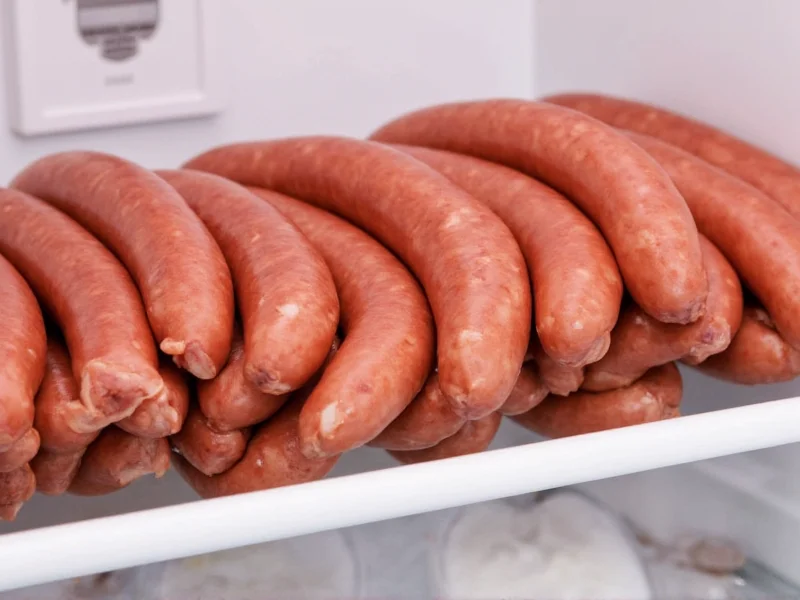Proper food storage prevents waste and protects your health. Understanding sausage shelf life helps you avoid foodborne illnesses while maximizing freshness. This guide provides science-based recommendations from food safety experts to help you store sausages correctly.
Understanding Sausage Shelf Life in the Refrigerator
Sausage longevity depends on several factors including preparation method, ingredients, and storage conditions. The USDA Food Safety and Inspection Service establishes clear guidelines for safe sausage storage that every home cook should know.
Different Sausage Types and Their Refrigerator Lifespans
Not all sausages share the same shelf life. Here's a detailed breakdown of how long various sausage types remain safe in your refrigerator:
| Sausage Type | Refrigerator Storage Time | Notes |
|---|---|---|
| Raw fresh sausages (pork, beef, chicken) | 1-2 days | Includes breakfast sausages and bratwurst before cooking |
| Cooked sausages | 3-4 days | Properly stored in airtight container |
| Smoked sausages (unopened) | 2 weeks | Check "use by" date on packaging |
| Smoked sausages (opened) | 7 days | Must remain refrigerated |
| Pre-cooked sausages (unopened) | 2 weeks | Follow package instructions |
| Pre-cooked sausages (opened) | 7 days | Store in original packaging or airtight container |
Optimal Refrigeration Practices for Sausages
How you store sausages significantly impacts their freshness and safety. Follow these professional storage techniques to maximize shelf life:
- Maintain your refrigerator at 40°F (4°C) or below - use a thermometer to verify
- Store raw sausages in their original packaging until ready to use
- Place raw meats on the bottom shelf to prevent cross-contamination
- Transfer opened sausages to airtight containers or resealable bags
- Wrap sausages tightly in aluminum foil or plastic wrap if original packaging is compromised
- Label containers with storage dates for easy tracking
Recognizing Spoiled Sausage: Critical Warning Signs
Knowing when sausage has spoiled prevents foodborne illness. Watch for these unmistakable signs that your sausages have exceeded their safe consumption period:
- Texture changes - slimy or sticky surface that wasn't present originally
- Color deterioration - grayish hue, green spots, or unusual discoloration
- Odor development - sour, rancid, or unpleasant smell (fresh sausage has mild meaty aroma)
- Package swelling - indicates bacterial growth producing gases
- Mold appearance - fuzzy spots in various colors (white, green, black)
When in doubt, throw it out. Consuming spoiled sausage risks food poisoning from pathogens like Salmonella, E. coli, and Listeria.
Freezing Sausages for Extended Storage
When you can't use sausages within recommended refrigerator timeframes, freezing preserves quality and safety:
- Raw sausages maintain best quality for 1-2 months in the freezer
- Cooked sausages stay fresh for 2-3 months when frozen
- Use heavy-duty freezer bags or airtight containers to prevent freezer burn
- Remove as much air as possible from packaging before freezing
- Thaw frozen sausages in the refrigerator, not at room temperature
Food Safety Considerations for Sausage Consumption
Proper handling prevents foodborne illness. Always follow these critical safety practices:
- Cook raw sausages to an internal temperature of 160°F (71°C) for beef, pork, and lamb varieties
- Cook poultry sausages to 165°F (74°C)
- Never leave sausages at room temperature for more than 2 hours (1 hour if above 90°F/32°C)
- Use separate cutting boards for raw meats and ready-to-eat foods
- Wash hands thoroughly after handling raw sausage
Common Questions About Sausage Refrigeration
Can I eat sausages after the sell-by date if they're still in the fridge?
Yes, you can safely consume sausages for 1-2 days after the sell-by date if properly refrigerated. The sell-by date indicates when stores should remove products, not when food becomes unsafe. Always check for spoilage signs regardless of dates.
How long do cooked sausages last in the refrigerator compared to raw?
Cooked sausages remain safe for 3-4 days in the refrigerator, while raw sausages only last 1-2 days. Cooking destroys surface bacteria, extending shelf life. Always store cooked sausages in airtight containers to maximize freshness.
What's the proper way to store opened smoked sausage in the fridge?
After opening smoked sausage, transfer it to an airtight container or resealable plastic bag. Press out excess air before sealing. Store on a refrigerator shelf (not the door) at 40°F (4°C) or below. Consume within 7 days for optimal safety and quality.
Can I tell if sausage is bad just by smelling it?
Smell is a reliable indicator of spoilage in sausage, but not the only one. Spoiled sausage develops a sour or rancid odor. However, some dangerous bacteria don't produce noticeable odors. Always check for multiple spoilage signs including texture changes, discoloration, and mold before consuming.
Does vacuum-sealed sausage last longer in the refrigerator?
Yes, vacuum-sealed sausage maintains freshness longer than conventionally packaged sausage. Unopened vacuum-sealed raw sausage can last 2-3 weeks in the refrigerator. Once opened, treat it like regular sausage with 1-2 day shelf life. Always check for package integrity before consumption.











 浙公网安备
33010002000092号
浙公网安备
33010002000092号 浙B2-20120091-4
浙B2-20120091-4